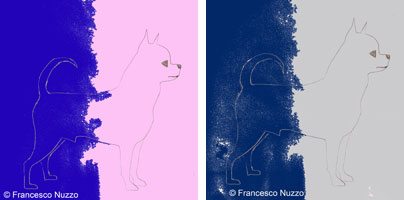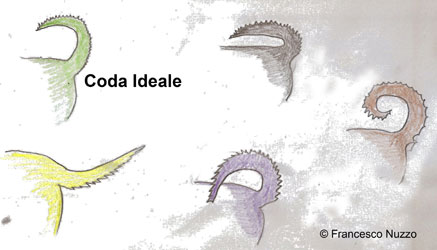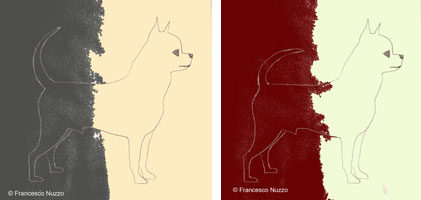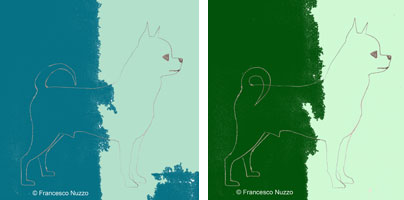- WELCOME
- HOME
- ABOUT US
- CHAMPIONS
-
VERY IMPORTANT DOG
- Ch. South Fork's Jelly Bean
- Ch. South Fork's The Beat Goes On
- Ch. Yo Te Quiero Di Rio Galeria
- Ch. South Fork' Jazz It Up
- Ch. Tocai Di Rio Galeria
- Ch. South Fork's Contradiction
- Ch. South Fork's Music Man
- Ch. El Nino Di Rio Galeria
- Ch. Xsaraja Di Rio Galeria
- Ch. De Gozette Lotus
- Ch. Eldorado Di Rio Galeria
- Ch. Jaqueline Di Rio Galeria
- Ch. Dacarella's Hellf Angel
- SHOW RESULTS
- PUPPIES
- INFO CHIHUAHUA
- CONTACTS
- TOOLS
Dog Expertise
By Paolo Tartaro and Francesco di Paola Nuzzo
- Source: Magazine All About Chihuahua n° 7
| In this usual issue dedicated to the deepening of the morphological aspects of the Chihuahua, we consider a single part of the body: the tail, a topic often overlooked in conformation evaluation. The deportment and shape of the tail are essential in determining the type and character, and are of great importance in dynamics and mechanics of movement Today, too often, when examining and describing the tail, we simply say superficial expressions such as "the tail is carried well" or viceversa "is not carried well," tight definitions that can say everything or nothing. In the history of the anatomical evaluation of the breed, there is no mention of the tail, enough is to note that in 1923 there was a delay in drawing up the first breed standard just because of the"tail", issue. Only when the pioneers of the breed, agreed that the tail had to be a semicircle, halfway, between the so-called mouse tail and the furry and flat tail. |
| Going back in time, some of the early breeders even claimed that the Chihuahua's characteristic was not the fontanella or "Molera," but a small mass of fat located in the middle of the tail length, we can say that fat accumulation was certainly lacking in tailless subjects allowed and not disqualified in the "pre-standard" era. If this anatomic part was a reason for ponder and debate in the past, delaying the release of a standard, it seems right to us today, to be reconsider and to be revalued, in order to regain its proper value. The tail is the terminal part of the spine the caudal appendix that extends beyond the trunk. Located between the rump and anal region, its anatomical base is on the region of the coccygeal vertebrae and muscles (raising and lowering). |
|
| Its conical shape is elongated, articulates with the rump through the sacrococcygeal joint. This part is called the root of the tail, while the other side, the end of the tail, is called the tip, there are two profiles, the upper and the lower. In evaluating the tail we must examine the following characteristics: insertion, length, shape, direction and deportment. Tail carriage should be evaluated at two different times: while the dog is at rest and while he is in action. Our breed standard requires: Tail set high, moderately long, broad at the base decreasing gradually towards the tip and visibly flat. As discussed in the previous issue of CAA, the croup affects the insertion of the tail: in fact a, wide and strong croup, almost horizontal or slightly tilted leads to a proper insertion of the tail and once again we see how each region is linked in shaping the other region. | |
 |
The standard says tail "moderately long" which, in dog-science, it can be said of a tail when the tip reaches the calcaneum, (hock) and if it does not reaches it, is called short. A big role in its evaluation is played by the coat, which in the long-coat subjects will have to be rich and long to form the typical tassel. Even in the smooth-coat Chihuahua, are to be preferred those subjects with a tail rich of fur, where it will be rich at the root and then shrink toward the tip, thus giving the impression of a proper tail, in fact, in subjects with lack of hair, we find the unwanted mouse tail. |
Other important features required by the standards are the position of the tail in motion and when stationary. Tail carriage is an important characteristic of the breed: in movement will be carried high forming a curve, or in a semicircle with the tip directed toward the lumbar region, which contributes to the harmony of the whole, the tail should never be carried between the hindlegs nor curled below the topline; faults are the so-called "banana"tail, or a offset tail, and any other not supported by the standard, the tip should not, however, never reach the dorsal line. The ideal tail in movement should be a "sickle" on the back, a open semi-circle , never crushed on the back, with the tip pointing toward the lumbar region while at rest will be hanging over forming a slight hook. |
|
 |
The head-neck balancer also acts as a tensor of the lumbar spine), the tail has its role in the balance of the dog in movement, because of this function is called the rudder. |
diriogaleria@chihuahua.it | musicvelvet@chihuahua.it
Words and images ©2011 Di Rio Galeria & Music Velvet Kennels - All rights reserved | Web site by TwentyfourCatsandDogs ©


